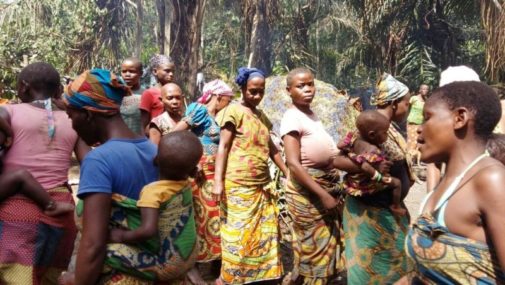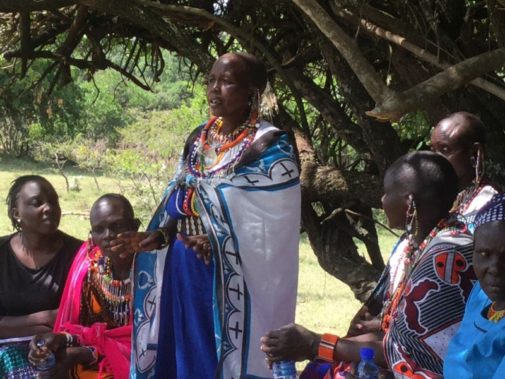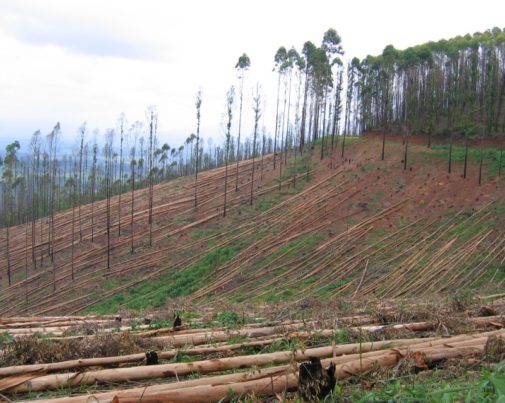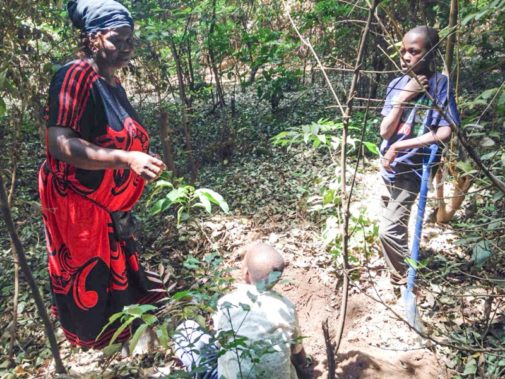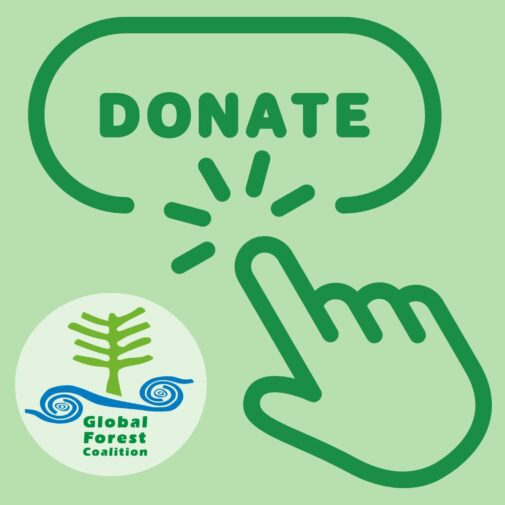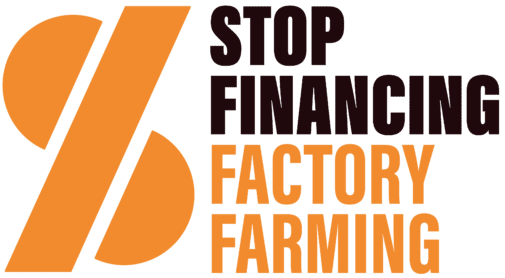Forest Cover 56 – Community conservation in Africa
 Welcome to the 56th issue of Forest Cover, the Global Forest Coalition’s magazine. It provides a space for environmental justice activists from across the world to present their views on international forest-related policies.
Welcome to the 56th issue of Forest Cover, the Global Forest Coalition’s magazine. It provides a space for environmental justice activists from across the world to present their views on international forest-related policies.
We are excited to bring you this special edition of Forest Cover on community conservation in Africa, which also contributes to discussions at the Conference of the Parties (COP) of the Convention on Biodiversity this November, which will take place in Egypt. It has been 18 years since a Biodiversity COP has been celebrated in Africa.
Africa’s rich biodiversity is facing multiple threats from industrial and extractive activities. Here we highlight five fantastic examples of community-led conservation and livelihood generation efforts. These stories from Uganda, Democratic Republic of Congo, Kenya, South Africa, and Tanzania reveal some of the threats that community conservation efforts face, but also how Indigenous Peoples and local communities are using their traditional knowledge and customary practices to protect and conserve biodiversity in their territories. The articles make important recommendations on the kind of policy support that can strengthen community initiatives.
We hope that policymakers, activists, community members, academics and journalists from around the world will take inspiration from these stories. Happy reading!
You can download the print version or read the articles individually below. To subscribe to the newsletter, please write to gfc@globalforestcoalition.org.
Download the print version in English (web quality | low resolution PDF) and French (web quality | low resolution PDF)
Contents:
Editorial: Community conservation is a strategic approach to saving the planet
Conservation by communities, for communities: An engine for sustainable
community livelihoods
Pygmy endogenous knowledge is at the heart of resilience and adaptation in the Democratic Republic of the Congo
Indigenous Peoples’ commitment to conservation and sustainability in Kenya
Trees and diapers threatening communities and biodiversity in South Africa
Tanzanian communities organise for environmental conservation
Editorial: Community conservation is a strategic approach to saving the planet
By Kwami D. Kpondzo, Les Amis de la Terre, Togo
Africa is one of the world’s biodiversity hotspots. It is a continent rich in natural resources, including forests. At present, the sustainable governance of Africa’s forests is facing numerous challenges.
This issue of Forest Cover is dedicated to exploring the challenges and successes of forest dwelling communities across Africa. On the one hand, people living in Africa’s forests are facing numerous challenges. On the other hand, these communities are standing up for their rights and implementing good practices which allow them to save local biodiversity and livelihoods.
We are happy to announce that this is the first issue of Forest Cover to focus on community conservation initiatives in Africa. This issue gives Global Forest Coalition members and participants of the Community Conservation Resilience Initiative (CCRI) the opportunity to inform the world about their community- led conservation practices. Community conservation initiatives are important for forest governance and biodiversity protection in Africa. Through these initiatives, communities better understand the significance of their traditional knowledge and practices related to conservation. Importantly, the CCRI is based on participatory methods including Free, Prior and Informed Consent (FPIC). Communities are free to choose what is best for them.
It is imperative to remember that biodiversity is crucial for all humans. Biodiversity provides us with food and medicine, and an environment rich in biodiversity provides us with cultural and aesthetic values, spiritual enrichment, intellectual development, and space for recreation. Biodiverse ecosystems help to regulate the climate by sequestering carbon and regulating water flows. But sadly, communities are suffering because of biodiversity loss and the destruction of ecosystems, driven by the unprecedented commercial exploitation of our forests.
Community livelihoods depend on forests and biodiversity. People depend on the forest to meet their needs and solve their problems, particularly related to accessing food and remedying health issues.
Bearing in mind the critical role that nature plays, it is absolutely critical to conserve it, not only for the sake of humans, but also for nature’s own sake. Local communities and Indigenous Peoples have been doing this work for millennia through their own efforts across the world, not least of all in Africa. As part of customary conservation practices to prevent the destruction of forests and biodiversity loss, people have ascribed sacred qualities to forests or prohibited hunting during specific seasons. Such community conservation initiatives must be recognised and promoted to save the planet.
This issue of Forest Cover features five articles on community conservation initiatives across the African continent. Examples from DRC, Kenya, South Africa, Tanzania and Uganda are shared, involving reforestation with indigenous tree species, beekeeping projects and many more. The articles examine the skills and resources that different communities have used in their community conservation initiatives as well as the challenges that they face. Communities are confident about their traditional knowledge and practices.
Africa’s rich biodiversity faces numerous threats from human activities such as extractive industries, industrial agriculture and monoculture plantations. These activities are drivers of biodiversity loss and climate change, dangerously affecting local communities and their livelihoods. Climate change and rising average temperatures are leading to droughts, floods and community displacement. Drought has serious impacts on animals, crops and rivers. Flooding destroys houses and farmland, and temporarily disrupts community farming activities. Pastoralists in particular are vulnerable to climate change- driven drought and loss of biodiversity. They face increasing difficulty in finding food and water for their animals and themselves.
Extractive industries, industrial agriculture and monoculture plantations are typically accompanied by land-grabbing, destruction of forests, community displacement and conflicts.
Community lands are grabbed without adequate compensation. The forests that communities live in and on which they depend for their livelihoods are destroyed with no alternative livelihood options given. There are increasing levels of conflict and violence between local communities, government, and the multinational companies behind the land-grabbing and forest destruction. Intra-community conflict is also increasing as a result of the practice of ‘divide and rule’ and community displacement. These conflicts destroy communities and their livelihoods.
Finding and promoting real solutions to climate change could resolve most of these conflicts, but surprisingly many of the proposed mainstream solutions to overcome the global climate crisis—such as schemes to Reduce Emissions from Deforestation and Forest Degradation (REDD)—only make matters worse. Communities end up becoming even more desperate after the implementation of REDD projects, which limit community access and control over their lands and territories. Truly effective solutions, like the community conservation initiatives explored in this issue, need to be scaled up.
Building local movements and solidarity are key elements of community conservation. The building of local movements allows communities to share their experiences from the implementation of their traditional knowledge and practices. Solidarity around innovative community conservation initiatives and the showcasing of good conservation practices will positively change the world.
Conservation by communities, for communities: An engine for sustainable community livelihoods
By David Kureeba, National Association of Professional Environmentalists (NAPE), Uganda
The Community Conservation Resilience Initiative (CCRI) is important in this era of climate change. Community-based conservation initiatives must be prioritised when Africa’s land— including forests, wetlands, and sacred natural sites—are increasingly targeted for industrialisation by corporations.
Our governments in Africa often don’t emphasise the participation of local communities in decision- making processes, with women being marginalised from decision- making power to an even greater extent. This state of affairs poses a challenge for community conservation initiatives. To meet this challenge, the CCRI was introduced.
The CCRI uses a bottom-up approach to examine the resilience of a range of initiatives and biocultural approaches used by Indigenous Peoples’ and local communities to conserve and restore biodiversity. Potential legal, political, socio-economic, financial, technical, and capacity-building support was also examined by the CCRI, to sustain and strengthen these initiatives and approaches.
The assessment in Uganda involved eight communities, and analysed the specific rights, roles, and needs of women in biocultural approaches to biodiversity conservation and restoration. The analysis examined the implications of relevant human rights instruments, in particular instruments related to the rights of Indigenous Peoples.
The assessment process aimed to contribute to the development of rights-based, environmentally and socially sustainable, and financially sound biodiversity conservation and restoration policies. In this era of visible climate change, good policies are those that provide effective and appropriate forms of support to the endogenous, biocultural approaches to biodiversity conservation and restoration that are implemented by Indigenous Peoples’ and local communities.
The assessment found that different communities have different skills and resources, and that these are treasured by the communities. Examples of unique resources included food crops, species of plants and animals, and sacred natural sites, forests, and hills. While indigenous communities typically wanted to continue using and pass on their knowledge, it was found that the current generation—often influenced by government and faith-based groups—have characterised some indigenous traditional values as satanic, and have mounted a hate campaign against traditional lifestyles. This has weakened traditional conservation practices such as seed-saving, keeping animals and protecting sacred natural sites, which are biodiversity reservoirs that ensure long-term survival of the ecosystems. It has also alienated people from traditional practices.
It should be noted that most African governments treasure investors, at the expense of community livelihoods and the protection of biodiversity. In Uganda, the land tenure regime is too fragile to protect rights-holders from unscrupulous investors. If an investor wants to develop an area of community land, it is fairly easy for the investor to be granted access to it. In most cases, the community owners of the land are inadequately compensated and are not resettled, resulting in internal displacement.
The CCRI in Uganda looked at how communities can protect themselves against unscrupulous investors and destructive development plans, and actively promote development that improves the livelihoods of local communities. The CCRI created awareness among communities and developed their capacity to engage with governments and investors, to ensure that their rights are respected.
The introduction of oil palm and other plantations in most African countries, including in Uganda, has brought many human rights challenges. Communities suffer when their forests and land are grabbed by plantation companies.
The heavy use of chemicals in the oil palm business has also affected and polluted water sources and lake buffer zones that most communities depend on.
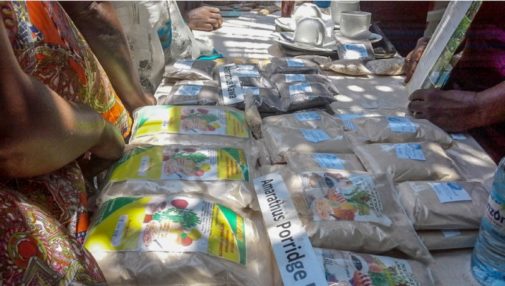
Some of the products harvested from community lands by groups participating in the Community Conservation Resilience Initiative. David Kureeba
Community livelihoods and sustenance depend on the land and all of the natural resources on it. Once this primary means of production is denied to communities, problems ensue. Communities depend on their territories to harvest food and medicines. They believe in their right to ownership of their ancestral land.
Communities in Uganda, and across Africa, have faced challenges related to the REDD+[1] programme, where they have been convinced to participate in carbon sequestration projects. This has been documented in the districts of Kalangala and Mayuge in Uganda. REDD+ targets the conservation of natural forests and aims to benefit smallholders and forest dependent communities, but in reality it is a false approach that promotes corporations and governments at the expense of the livelihoods of Indigenous Peoples. The promition of “Climate-Smart” agriculture is similar, where agribusiness is favoured over the protection of indigenous seeds and foods, which are vital to communities’ food sovereignty.
Another challenge is that local government has limited knowledge of or committment to equality and equity. Despite the fact that Uganda has very inclusive gender policies, there is a need for knowledge of these policies to trickle down to the district and community-level staff to ensure that they are respected, and that gender-responsive programmes are budgeted for. This approach can ensure that women are included in the planning and decision-making processes, and that their concerns are addressed, especially since women are often disproportionately affected by development processes.
The government, private companies and development partners should respect the rights of forest-dependent communities and other local people in different constituencies. Land is a primary factor of production, and once a community has lost its land, its way of life and essentially disappears. International programmes such as REDD+, which create a market for for ecosystem services, are false solutions to climate change. Emissions reductions should be prioritised at the source of the emissions.
Plantations are not forests, and forest conservation should be done by communities, for the benefit of communities. Indigenous Peoples and their way of life have conserved the global environment for millennia, and their philosophies and methods should be respected and adopted if climate change mitigation is to be successful.
[1] REDD+ is a climate change mitigation project being developed by Parties to the United Nations Framework Convention on Climate Change (UNFCCC). https://www.unredd.net/about/what-is-redd-plus.html
Pygmy endogenous knowledge is at the heart of resilience and adaptation in the Democratic Republic of the Congo
By Diel Mochire, PIDP-KIVU, DRC
The Democratic Republic of the Congo (DRC) is located in the centre of Africa, and is considered the world’s second forest lung, after the Amazon. Rich in biodiversity, its forest ecosystems are internationally-recognised as hosting rich, endemic biological diversity, and natural resources of great importance. These forests are the habitat of numerous ‘flagship’ conservation species, such as mountain gorillas in the Kahuzi-Biega National Park and Ikobo-Pinga Forests. As well as biological diversity, the country also has vast mineral and water resources, which attract the attention of multinational corporations.
Pygmies were Central Africa’s first natural resource and forest conservationists
Four large ethnic groups live in the Democratic Republic of the Congo: the Bantu, the Nilotic, the Sudanese and the Pygmies. Practicing hunting and gathering, the indigenous Pygmies are considered the first inhabitants. They are known for their unique lifestyle and culture which is steeped in environmental conservation. Pygmy communities live semi-nomadically in the high Montane forests of the Great Lakes region of Central Africa.
Pygmy people are often considered to be guardians of the planet’s biological resources. Their lifestyle and values are renowned for integrating the protection of the environment and natural resources on which they rely. According to the Indigenous and Traditional Peoples of the World and Ecoregion Conservation: An Integrated Approach to Conserving the World’s Biological and Cultural Diversity report, 95% of the world’s ecoregions with the highest and most threatened biodiversity are situated on indigenous territories. The extent to which full recognition of the rights of Indigenous Peoples, including Pygmies, would positively impact biodiversity protection deserves further consideration.
Pygmies have extensive knowledge on local natural resources due to their daily relationship with the forest. Through their traditional knowledge and hunting and gathering lifestyle, Pygmies are privileged collaborators in forest and natural resource conservation.
Pygmies are seen as being instrumental to accustomising gorillas to the presence of humans and contribute to the success of the Kahuzi-Biega National Park (PNKB). Established in the early 1970s, it is the first park in the world to organise visits to view gorillas in their wild habitat. In 1996, during the war, when the Congolese Institute for the Conservation of Nature (ICCN) lost control of the Park, the Pygmies protected and guarded gorilla families in the tourist areas. These days, Pygmies work as guides for tourists in the Park.
Pygmy communities have collaborated with scientific researchers and provide considerable assistance to conservation work. They share precise information about faunal, floral and aquatic species, including the identification, distribution, eco- ethology, and traditional use of species by Pygmy communities. They certainly deserve to be recognised as co-authors of scientific work on conservation in Central Africa, but often researchers and those responsible for the biopiracy of Pygmy indigenous knowledge do not seem to embrace this idea.
Thanks to their vast knowledge of the forests, Pygmies are very important for anti-poaching operations as they provide clear and accurate information on the activities and whereabouts of poachers. Through the support of local Pygmy communities, the killing of gorillas and elephants has been reduced by 25% in national parks and natural forests.
With their help, more than 3,000 metal collars for small mammals were seized in one month. By reporting on the movement of poachers, they have contributed to reducing the number illegal entries into national parks.
Two traditional ceremonies are characteristic of the involvement of Pygmy communities in gorilla conservation. Firstly, the “sheep rite” takes place once a year, and aims to save gorillas during natural calamities and external attacks. Secondly, Park Executives are subject to an induction ceremony, which ensures that they protect the forest and its resources, including gorillas, effectively.
The first forest concession issued to Pygmy communities: Babuluko in Walikale territory
The first community land concession to be granted to Indigenous Peoples by the Congolese government is called “Kisimbosa Chamakasa”, which means “fertile land”. The concession was granted through a decree made by the provincial government. The concession land is approximately 15,101 hectares and includes five main hills: Chankuba, Mashogho, Mabaka, Kambushi and Sankakemenge. The forest concession encompasses four Babuluko Pygmy villages; Kissa, Kilali, Lufito and Kambuchi.
The community forestry process is based on the existing legal framework established by the Democratic Republic of the Congo, which includes: The Republic Constitution (Articles 34, 53, 56 and 207); Act No. 011/2002 of 29th August 2002 on the Forest Code in the Democratic Republic of Congo (Articles 22, 111, 112 and 113) recognising and protecting the rights of communities to customary forest ownership; Decree No. 14/018 of August 2nd 2014 which outlines the procedures for allocating forest concessions to local communities; and Ministerial Order No. 025 / CAB / MIN / ECN- DDCCJ / 00 / RBM / 2016 of February 9th 2016 on the specific provisions for the management and operation of local community forest concessions.
The aim of the community forestry process is to ensure the management and sustainable use of forests and natural resources for the benefit of present and future generations. The characteristics of the process are unique: it is participative and inclusive of all stakeholders, social and socio-professional strata (for example, young people, women, older people, ethnic minorities including Bantu and Pygmies, and local and customary authorities).
The area of the concession has been occupied for thousands of years by Indigenous Peoples, and control of the land is their customary right. Thanks to their traditional knowledge and conservation practices, the area has kept its natural integrity despite facing multiple threats. The Babuluko Pygmy communities have developed practices and values that have enabled them to withstand these challenges and threats.
The role of Pygmy women in the conservation of biocultural areas
Humans are central to the concept of sustainable development, which entitles people to a healthy and productive life in harmony with nature. Women have a fundamental role to play in adopting environmentally- sustainable patterns of consumption, production and management of natural resources, as agreed by the United Nations Conference on Environment and Development.
Women sustain their families and communities by managing and using natural resources wisely, both as consumers and producers. Due to their role in preserving the quality of life for present and future generations, women have an important role to play in promoting sustainable development.
The situation of rural women and women workers in the agricultural sector should be recognised, and particular attention should be paid to their needs. Access to training, land, natural resources, credit, development programmes and cooperative structures can help them to become more involved in sustainable development. Exposure to environmental risks at home and at work can have a disproportionate impact on women’s health, and it is is particularly at risk in both urban and low-income areas where there are high levels of industrial pollution.
Internal and external challenges to community conservation
There are a range of internal and external challenges to successful community conservation:
• Illegal logging and mining in indigenous areas and territories without the Free, Prior and Informed Consent of indigenous Pygmy peoples;
• Development of technology;
• Creation and extension of protected areas without the Free, Prior and Informed Consent of communities;
• Development of practices that undermine and threaten the culture of the Pygmy Babuluko Indigenous People;
• Social disrepute of Indigenous Peoples in Walikale territory is one of the causes of the lack of access to natural resources;
• Population growth;
• Land grabbing;
• Granting of hunting permits to local communities that organise illegal hunting and fishing on the Babuluko Pygmy indigenous territory;
• Insecurity due to the presence of armed groups that include local neighbors of tho Babuluko Pygmy Indigenous Peoples (these armed groups have organised looting in indigenous Pygmy villages such as Kissa);
• Unsuitability of legal texts to local realities of management and
governance of natural resources by Babuluko communities;
• Slash-and-burn agriculture practiced by neighbours of the Babuluko Pygmy Indigenous Peoples;
• A project establishing an ecological corridor through Pygmy land;
• Legal regimes applicable to other natural resources, such as mining for minerals and hydrocarbons, do not recognise customary appropriation.
Principal recommendations
• Community regulation of hunting and fishing;
• Environmental education for children and all social classes;
• Valorisation of traditional knowledge and practices of Indigenous Peoples
through the production of works of art and the organisation of cultural events;
• Establishment of an agricultural intensification plan and the fight against slash-and-burn agriculture;
• Implementing anti-poverty initiatives through the promotion of Income
Generating Activities.
Indigenous Peoples’ commitment to conservation and sustainability in Kenya
By Lucy Mulenkei, Indigenous Information Network (IIN), Kenya, and Edna Kaptoyo, International Alliance of Indigenous and Tribal Peoples of the Tropical Forests (IAITPTF), Kenya
In Kenya, Indigenous Peoples’ territories are home to important biodiversity. Forest management by Indigenous Peoples provides social, cultural, economic and environmental benefits to the communities themselves and the entire country. Indigenous groups like the Maasai of the Nyekweri Kimintet forest and the Rendille of Mount Marsabit live in harmony with wildlife, and conserve forests through their customary laws and values.
The Nyekweri Kimintet forest, which borders the famous Maasai Mara National Park, is a significant breeding area for elephants from the reserve. To combat external threats to conservation, the Maasai community formed a trust to ensure the continued conservation of biodiversity and to prevent conversion of forest land. Findings from the 2017 Community
Conservation Resilience Initiative in Kenya showed that Indigenous Peoples, and particularly women, have been playing a key role in conserving biodiversity and maintaining traditional knowledge relevant to conservation through ensuring the intergenerational transmission of vital knowledge and values. In Kenya, Indigenous Peoples maintain strong connections with the natural environment and values related to conservation are rooted in their culture. For example, the Rendille traditionally only cut down tree branches to use for house construction, and harvest herbal medicine sustainably. As pastoralists, Rendille communities plan their migration routes to allow for the regeneration of vegetation, ensuring a sustainable food source for their livestock.
The Kenyan government has a comprehensive policy and legal framework for environmental protection. The Environment Management and Coordination Act asserts various environmental rights and responsibilities. The general principles of the Act are founded on Article 42 of the 2010 Constitution, which provide every citizen the right to a clean and healthy environment, including the right to have their environment protected for the benefit of present and future generations. Currently the government is reviewing its National Biodiversity Strategy and Action Plan (NBSAP), and there are indications that the government recognises the importance of community conservation and traditional knowledge in achieving the strategic actions laid out in the NBSAP. In Kenya, community conservation has without a doubt been a significant contributor to the achievement of the Aichi Biodiversity Targets and Sustainable Development Goals 13 and 15, as well as other cross- cutting goals.
However, community conservation in Kenya faces a number of challenges. One challenge is the impact of climate change, which has caused severe drought, species extinction, and other adverse impacts. At a time when many people are choosing to abandon community conservation, the Maasai and Rendille peoples maintain that their land is part of them and that environmental protection is crucial to their livelihoods and cultural practices. As one indigenous woman put it, “we cannot talk about protecting Indigenous Peoples’ and women’s rights without protecting and conserving the land and resources which we are part of.” Another challenge is a lack of legal protection for community forests by the county and national-level laws, and institutions tasked with providing protection. In practice, the legal framework recognises the role of community forests in biodiversity conservation and ecosystem services, but does not support communities to strengthen their conservation activities.
The vision of indigenous communities is to see land, forests and natural resources conserved for future generations, and to acheive this they call for support for community conservation initiatives from county and national government, environmental authorities and development partners. The Maasai and Rendille peoples want to raise public awareness of the positive contribution that community conservation makes towards achieving the Sustainable Development Goals and Aichi Targets, and to strengthen community land rights as well as engagement with Indigenous Peoples’ and women’s groups as advocates of environmental conservation. Meaningful engagement with Indigenous Peoples’ and women’s groups is needed to tip the balance towards sustainable use and conservation in Kenya, as well as to ensure that the government is meeting its commitments.
Trees and diapers threatening communities and biodiversity in South Africa
By Phillip Owen, Geasphere, South Africa
The Community Conservation Resilience Initiative (CCRI) process in South Africa underscored environmental issues relevant to our region and of particular concern to the communities dependant on local ecosystems.
All around us we can see degradation of nature, desertification, biodiversity impoverishment, pollution from mining, large scale agriculture, carbon-based transport systems and society’s growing consumerism.
All participants in the local CCRI process agreed that industrial timber plantations constitute one of the biggest threats to environmental integrity, reaching far beyond the physical areas where they are being grown.
One of the most immediate consequences of the establishment of industrial timber plantations is the usurpation of water resources. Approximately three years after establishment of eucalyptus plantations, local water resources become compromised. Eucalyptus plantations consume approximately 35% more water than pine species, due to their broader leaves and deep roots (eucalyptus roots have been measured 50m+ into the soil profile). A single eucalyptus tree can use more than 100 litres of water daily.
In addition, local plantations lead to the destruction of grasslands, compromising the ‘water retention’ and ‘flood prevention’ services this natural vegetation type provides. It is clearly evident that soil erosion has increased in timber production areas, with higher turbidity in the remaining dwindling water resources.
Climate change is manifesting itself in more extreme weather, including prolonged dry spells broken by heavy rain, storms and flood events. Even though such weather events have occurred in the past, long before the establishment of large- scale industrial timber plantations, these events are now compounded by general land degradation and fragmentation of natural habitats.
Timber plantations are highly flammable, and during intensified ‘dry spells’ this presents a problem of alarming proportion. Some plantation fires burn out of control, leading to tragic loss of life and livelihoods, and long-term consequences for the environment due to the scorched, dead earth left in the wake of such intense fires.
Timber plantations should not be promoted as ‘forests’. Monoculture plantations should not be certified and legitimised by certification schemes such as the Forest Stewardship Council (FSC), unless there is diversity and multi-level utility within timber plantation compartments. This could be achieved by making full use of the ‘understory’ for growing of food, herbs and alternative fibre crops, and by incorporating animals into the system, thereby maximising job opportunities and livelihood choices.
Furthermore, timber plantations should be ‘fragmented’ by establishing wide (200m minimum) ecological corridors within them, to act as sinks for nature and as ‘buffer zones’ to assist in fire management and control. Such corridors should be managed to maximise natural biodiversity, in order to promote environmental resilience on a landscape level.
The establishment of industrial timber plantations is driven by global over-consumption of paper products, including sanitary products like diapers that require significant amounts of softwood pulp. This is indicative of the overall growing problem of global consumption patterns and general apathy towards the environment. The use of disposable diapers in South Africa has escalated dramatically over the past two decades, and this issue was raised by CCRI participants as it is linked to another major environmental problem impacting nature and communities.
In a community where there are well- established waste removal services and infrastructure, used disposable diapers find their way into waste dumps, as they cannot be recycled or re-used. The absorbent material and plastic components of disposable diapers make them extremely resistant to decomposition. In landfill conditions, disposable diapers can last for more than 500 years before deteriorating. Where waste dumps are properly constructed and lined with non-permeable material, the waste problem is shifted to future generations to deal with. Most waste dumps in South Africa are not ‘lined’—so the human waste and chemicals contained in disposable diapers leaches into the underground water and environment generally, leading to increased environmental degradation and escalating health risks.
Many communities in South Africa and Africa in general live in areas where there are limited or no waste removal services. In these cases, people often discard used diapers along the roadside, or simply throw these items off bridges into waterways, streams and rivers. Local residents dependant on these sources for daily water requirements are most severely impacted, and are confronted with this new and growing threat to health and livelihoods. In Southern Africa, traditional health practitioners often use rivers and streams in their rituals and healing practices. Now these places are often compromised by used diapers, an icon for our ‘throw away’ consumer society.
In South Africa, approximately 4 billion disposable diapers are being used annually, and it seems we can indeed be described as a ‘shit-hole country’. But this problem is not unique to South Africa: in the UK another 4 billion are used, in Germany 5 billion, and in the USA approximately 40 billion disposable diapers are being used each year. Globally, a staggering 450 billion diapers are used annually, resulting in around 77 million tons of solid waste entering landfill sites.
Confronted with these numbers it is clear that the need for change is becoming urgent, and a monumental and collective effort is needed from our global society. The Absorbent Hygiene Products Industry (i.e. Kimberly Clarke and Proctor & Gamble) need to put more resources towards products which are recyclable and/or safely compostable.
Re-usable cloth diapers should be promoted, and alternatives to diapers such as the ‘elimination communication’ method should be tested.
At the very least, the corporations producing these products should inform their customers as to the negative impacts associated with the use of disposable diapers, so as to ensure consumers can make informed decisions in exercising their choice.
It is apparent that we live on a fragile planet with finite resources. We are linked globally through complex interactions, and what we do in one country or continent affects other areas. Toxic chemical run-off from agribusinesses and mining ventures pollute the land, and vast islands of plastic pollution in the worlds oceans are commonplace.
As well as the various initiatives that have been instigated and the relationships formed between participants, what has emerged from the CCRI process is a stronger awareness and a deeper realisation that we can no longer continue along the current path of destructive consumerism, and that we will have to act as a collective to make change happen.
Tanzanian communities organise for environmental conservation
By Salome Kisenge, Envirocare, Tanzania
Men and women from Ngasinyi village (Kahe, Moshi Rural District, Kilimanjaro) and Wiri, Lawate and Sanya Juu villages (Siha District) have been implementing community conservation initiatives, facilitated by Envirocare[1] and with support from the Global Forest Coalition.
In these communities, people have organised themselves into environmental conservation working groups to address the degradation of their local natural resources.
Each village has an Environmental Committee which oversees issues of environmental conservation, develops village plans and ensures environmental by-laws are enforced.
Community members have tried their best to plant indigenous trees around rivers, as they grow very well in the area. They also practice beekeeping, which is important for their income and livelihoods.
In Ngasinyi village, people have been cutting down trees in forests that were traditionally used for the preservation of culture and the conservation of biodiversity, which is causing deforestation. Trees are being cut down for the production of charcoal and as fuel for brick- making operations. This commercial logging activity is illegal under the Forest Act of 2002, the National Forest Policy of 1998 and the Environmental Policy of 1997.
The village has also been suffering from water pollution from large- scale cultivation of maize, beans and rice, established by investors. Oil leakages from the water pumps used by agricultural labourers has been polluting water sources used by local people for irrigation and domestic purposes, posing threats to both human health and the environment. Parallel to this, climate change is seen to be the cause of drought, as local water sources have been decreasing following less rainfall and long periods of strong sun. After villagers and local leaders informed the District Commissioner and Police about their water pollution problems, they acted to ensure the investors stopped polluting the water and the water pumps were moved away from local water sources.
In Lawate village, community members have planted indigenous trees. These perform better than the non-native trees, which suck a lot of water from soils. For example, Dakika Tatu/Three Minutes trees were provided by the District Council for people to plant in their areas. They were once planted due to their fast growth, but they were also decreasing soil fertility. Crops grown in the area where Dakika Tatu trees were planted did not perform well. Community members reported the matter to the village leadership, who reported the same to the District Council, and the council ordered the trees to be uprooted for environmental conservation.

Women from Wiri and Sanya Juu villages discuss and map their community biodiversity resources, problems and prioritise actions for restoration. Salome Kisenge
People from Wiri village, in Siha District, are also faced with increasing deforestation in their area. Deforestation has been occurring around water sources such as Lake Magadi (a saline lake) where young trees have been planted, but are consumed by livestock. The Maasai communities living around Lake Magadi are pastoralists and keep cattle, goats, sheep and other livestock. But the abundance of trees and grass that their animals feed on has been decreasing, putting pressure on their way of life. The situation has been made worse by climate change, where rainfall patterns have changed, resulting in long periods of strong sun and dry weather, which has hindered the growth of trees and other vegetation.
Because of this, village leaders, in collaboration with environmental committees, District Council Natural Resources Officers and the Envirocare team, have raised awareness of environmental conservation in the area by
planting suitable, indigenous trees, which fertilise the soil, and provide animal fodder, medicines, and firewood, and have ornamental value.
[1] Envirocare is non-profit, non-governmental, registered organisation founded in 1993. Envirocare’s holistic approach addresses the connections between poverty, gender and human rights. http://envirocare.or.tz/about-us/
Editorial Team: Ashlesha Khadse, Kwami Kpondzo, Mary Louise Malig and Simone Lovera
Editor: Michael Braverman
Graphic Design & Photo Research: Oliver Munnion
Donate to GFC here.
This Forest Cover was made possible through support from the International Climate Initiative (IKI) of the The Federal Ministry of the Environment, Nature Conservation and Nuclear Safety (BMU). The participatory CCRI assessments described in this issue were also made possible through financial contributions from the Christensen Fund and the Siemenpuu Foundation. The views expressed in this publication are not necessarily the views of our contributors.






